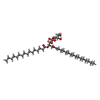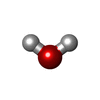+ データを開く
データを開く
- 基本情報
基本情報
| 登録情報 |  | |||||||||
|---|---|---|---|---|---|---|---|---|---|---|
| タイトル | CryoEM structure of cyclised H-pilus | |||||||||
 マップデータ マップデータ | sharpened map | |||||||||
 試料 試料 |
| |||||||||
 キーワード キーワード | Pilus / Conjugation / Filament / PROTEIN FIBRIL | |||||||||
| 機能・相同性 | membrane / Pili assembly chaperone 機能・相同性情報 機能・相同性情報 | |||||||||
| 生物種 |  Salmonella (サルモネラ菌) Salmonella (サルモネラ菌) | |||||||||
| 手法 | らせん対称体再構成法 / クライオ電子顕微鏡法 / 解像度: 2.24 Å | |||||||||
 データ登録者 データ登録者 | Ishimoto N / Beis K | |||||||||
| 資金援助 | 1件
| |||||||||
 引用 引用 |  ジャーナル: Proc Natl Acad Sci U S A / 年: 2025 ジャーナル: Proc Natl Acad Sci U S A / 年: 2025タイトル: Cryo-EM structure of the conjugation H-pilus reveals the cyclic nature of the TrhA pilin. 著者: Naito Ishimoto / Joshua L C Wong / Shan He / Sally Shirran / Olivia Wright-Paramio / Chloe Seddon / Nanki Singh / Carlos Balsalobre / Ravi R Sonani / Abigail Clements / Edward H Egelman / Gad ...著者: Naito Ishimoto / Joshua L C Wong / Shan He / Sally Shirran / Olivia Wright-Paramio / Chloe Seddon / Nanki Singh / Carlos Balsalobre / Ravi R Sonani / Abigail Clements / Edward H Egelman / Gad Frankel / Konstantinos Beis /    要旨: Conjugation, the major driver of the spread of antimicrobial resistance genes, relies on a conjugation pilus for DNA transfer. Conjugative pili, such as the F-pilus, are dynamic tubular structures, ...Conjugation, the major driver of the spread of antimicrobial resistance genes, relies on a conjugation pilus for DNA transfer. Conjugative pili, such as the F-pilus, are dynamic tubular structures, composed of a polymerized pilin, that mediate the initial donor-recipient interactions, a process known as mating pair formation (MPF). IncH are low-copy-number plasmids, traditionally considered broad host range, which are found in bacteria infecting both humans and animals. The reference IncHI1 plasmid R27, isolated from serovar Typhi, encodes the conjugative H-pilus subunit TrhA containing 74 residues after cleavage of the signal sequence. Here, we show that the H-pilus forms long filamentous structures that mediate MPF and describe its cryoelectron-microscopic (cryo-EM) structure at 2.2 Å resolution. Like the F pilus, the H-pilin subunits form helical assemblies with phospholipid molecules at a stoichiometric ratio of 1:1. While there were previous reports that the T-pilus from was composed of cyclic subunits, three recent cryo-EM structures of the T-pilus found no such cyclization. Here, we report that the H-pilin is cyclic, with a covalent bond connecting the peptide backbone between the N and C termini. Both the cryo-EM map and mass spectrometry revealed cleavage of the last five residues of the pilin, followed by cyclization via condensation of the amine and carboxyl residues. Mutagenesis experiments revealed that loss of cyclization abolished pilus biogenesis and efficient plasmid transfer. The cyclic nature of the pilin could stabilize the pilus and may explain the high incidence of IncH plasmid dissemination. | |||||||||
| 履歴 |
|
- 構造の表示
構造の表示
| 添付画像 |
|---|
- ダウンロードとリンク
ダウンロードとリンク
-EMDBアーカイブ
| マップデータ |  emd_52431.map.gz emd_52431.map.gz | 12 MB |  EMDBマップデータ形式 EMDBマップデータ形式 | |
|---|---|---|---|---|
| ヘッダ (付随情報) |  emd-52431-v30.xml emd-52431-v30.xml emd-52431.xml emd-52431.xml | 19.3 KB 19.3 KB | 表示 表示 |  EMDBヘッダ EMDBヘッダ |
| FSC (解像度算出) |  emd_52431_fsc.xml emd_52431_fsc.xml | 10.6 KB | 表示 |  FSCデータファイル FSCデータファイル |
| 画像 |  emd_52431.png emd_52431.png | 146.8 KB | ||
| マスクデータ |  emd_52431_msk_1.map emd_52431_msk_1.map | 129.7 MB |  マスクマップ マスクマップ | |
| Filedesc metadata |  emd-52431.cif.gz emd-52431.cif.gz | 6 KB | ||
| その他 |  emd_52431_half_map_1.map.gz emd_52431_half_map_1.map.gz emd_52431_half_map_2.map.gz emd_52431_half_map_2.map.gz | 120.4 MB 120.4 MB | ||
| アーカイブディレクトリ |  http://ftp.pdbj.org/pub/emdb/structures/EMD-52431 http://ftp.pdbj.org/pub/emdb/structures/EMD-52431 ftp://ftp.pdbj.org/pub/emdb/structures/EMD-52431 ftp://ftp.pdbj.org/pub/emdb/structures/EMD-52431 | HTTPS FTP |
-検証レポート
| 文書・要旨 |  emd_52431_validation.pdf.gz emd_52431_validation.pdf.gz | 987.3 KB | 表示 |  EMDB検証レポート EMDB検証レポート |
|---|---|---|---|---|
| 文書・詳細版 |  emd_52431_full_validation.pdf.gz emd_52431_full_validation.pdf.gz | 986.8 KB | 表示 | |
| XML形式データ |  emd_52431_validation.xml.gz emd_52431_validation.xml.gz | 19.2 KB | 表示 | |
| CIF形式データ |  emd_52431_validation.cif.gz emd_52431_validation.cif.gz | 24.5 KB | 表示 | |
| アーカイブディレクトリ |  https://ftp.pdbj.org/pub/emdb/validation_reports/EMD-52431 https://ftp.pdbj.org/pub/emdb/validation_reports/EMD-52431 ftp://ftp.pdbj.org/pub/emdb/validation_reports/EMD-52431 ftp://ftp.pdbj.org/pub/emdb/validation_reports/EMD-52431 | HTTPS FTP |
-関連構造データ
| 関連構造データ |  9hvcMC M: このマップから作成された原子モデル C: 同じ文献を引用 ( |
|---|---|
| 類似構造データ | 類似検索 - 機能・相同性  F&H 検索 F&H 検索 |
- リンク
リンク
| EMDBのページ |  EMDB (EBI/PDBe) / EMDB (EBI/PDBe) /  EMDataResource EMDataResource |
|---|
- マップ
マップ
| ファイル |  ダウンロード / ファイル: emd_52431.map.gz / 形式: CCP4 / 大きさ: 129.7 MB / タイプ: IMAGE STORED AS FLOATING POINT NUMBER (4 BYTES) ダウンロード / ファイル: emd_52431.map.gz / 形式: CCP4 / 大きさ: 129.7 MB / タイプ: IMAGE STORED AS FLOATING POINT NUMBER (4 BYTES) | ||||||||||||||||||||||||||||||||||||
|---|---|---|---|---|---|---|---|---|---|---|---|---|---|---|---|---|---|---|---|---|---|---|---|---|---|---|---|---|---|---|---|---|---|---|---|---|---|
| 注釈 | sharpened map | ||||||||||||||||||||||||||||||||||||
| 投影像・断面図 | 画像のコントロール
画像は Spider により作成 | ||||||||||||||||||||||||||||||||||||
| ボクセルのサイズ | X=Y=Z: 1.02 Å | ||||||||||||||||||||||||||||||||||||
| 密度 |
| ||||||||||||||||||||||||||||||||||||
| 対称性 | 空間群: 1 | ||||||||||||||||||||||||||||||||||||
| 詳細 | EMDB XML:
|
-添付データ
-マスク #1
| ファイル |  emd_52431_msk_1.map emd_52431_msk_1.map | ||||||||||||
|---|---|---|---|---|---|---|---|---|---|---|---|---|---|
| 投影像・断面図 |
| ||||||||||||
| 密度ヒストグラム |
-ハーフマップ: half map A
| ファイル | emd_52431_half_map_1.map | ||||||||||||
|---|---|---|---|---|---|---|---|---|---|---|---|---|---|
| 注釈 | half map A | ||||||||||||
| 投影像・断面図 |
| ||||||||||||
| 密度ヒストグラム |
-ハーフマップ: half map B
| ファイル | emd_52431_half_map_2.map | ||||||||||||
|---|---|---|---|---|---|---|---|---|---|---|---|---|---|
| 注釈 | half map B | ||||||||||||
| 投影像・断面図 |
| ||||||||||||
| 密度ヒストグラム |
- 試料の構成要素
試料の構成要素
-全体 : H-pilus
| 全体 | 名称: H-pilus |
|---|---|
| 要素 |
|
-超分子 #1: H-pilus
| 超分子 | 名称: H-pilus / タイプ: organelle_or_cellular_component / ID: 1 / 親要素: 0 / 含まれる分子: #1 |
|---|---|
| 由来(天然) | 生物種:  Salmonella (サルモネラ菌) Salmonella (サルモネラ菌) |
| 分子量 | 理論値: 7.1 kDa/nm |
-分子 #1: Pili assembly chaperone
| 分子 | 名称: Pili assembly chaperone / タイプ: protein_or_peptide / ID: 1 詳細: The last five residues of AGIPL are cleaved when H-pilus make cyclisation. コピー数: 1 / 光学異性体: LEVO |
|---|---|
| 由来(天然) | 生物種:  Salmonella (サルモネラ菌) Salmonella (サルモネラ菌) |
| 分子量 | 理論値: 7.601941 KDa |
| 組換発現 | 生物種:  |
| 配列 | 文字列: GSDDGAFGDI WAYMSEALTG APGKIIACGM LFSVAYFGVV KPNLGLALVS ALMMLVMANG EKIISSFLDA GIPL UniProtKB: Pili assembly chaperone |
-分子 #2: 1,2-DIPALMITOYL-PHOSPHATIDYL-GLYCEROLE
| 分子 | 名称: 1,2-DIPALMITOYL-PHOSPHATIDYL-GLYCEROLE / タイプ: ligand / ID: 2 / コピー数: 1 / 式: LHG |
|---|---|
| 分子量 | 理論値: 722.97 Da |
| Chemical component information |  ChemComp-LHG: |
-分子 #3: water
| 分子 | 名称: water / タイプ: ligand / ID: 3 / コピー数: 31 / 式: HOH |
|---|---|
| 分子量 | 理論値: 18.015 Da |
| Chemical component information |  ChemComp-HOH: |
-実験情報
-構造解析
| 手法 | クライオ電子顕微鏡法 |
|---|---|
 解析 解析 | らせん対称体再構成法 |
| 試料の集合状態 | filament |
- 試料調製
試料調製
| 緩衝液 | pH: 8 |
|---|---|
| グリッド | モデル: Quantifoil R1.2/1.3 / 材質: COPPER / メッシュ: 300 / 前処理 - タイプ: GLOW DISCHARGE / 前処理 - 時間: 30 sec. |
| 凍結 | 凍結剤: ETHANE / チャンバー内湿度: 100 % / チャンバー内温度: 298 K / 装置: FEI VITROBOT MARK IV |
- 電子顕微鏡法
電子顕微鏡法
| 顕微鏡 | TFS KRIOS |
|---|---|
| 撮影 | フィルム・検出器のモデル: FEI FALCON IV (4k x 4k) 平均電子線量: 50.0 e/Å2 |
| 電子線 | 加速電圧: 300 kV / 電子線源:  FIELD EMISSION GUN FIELD EMISSION GUN |
| 電子光学系 | 照射モード: FLOOD BEAM / 撮影モード: BRIGHT FIELD / 最大 デフォーカス(公称値): 1.8 µm / 最小 デフォーカス(公称値): 0.8 µm |
| 試料ステージ | 試料ホルダーモデル: FEI TITAN KRIOS AUTOGRID HOLDER ホルダー冷却材: NITROGEN |
| 実験機器 |  モデル: Titan Krios / 画像提供: FEI Company |
 ムービー
ムービー コントローラー
コントローラー




 Z (Sec.)
Z (Sec.) Y (Row.)
Y (Row.) X (Col.)
X (Col.)













































